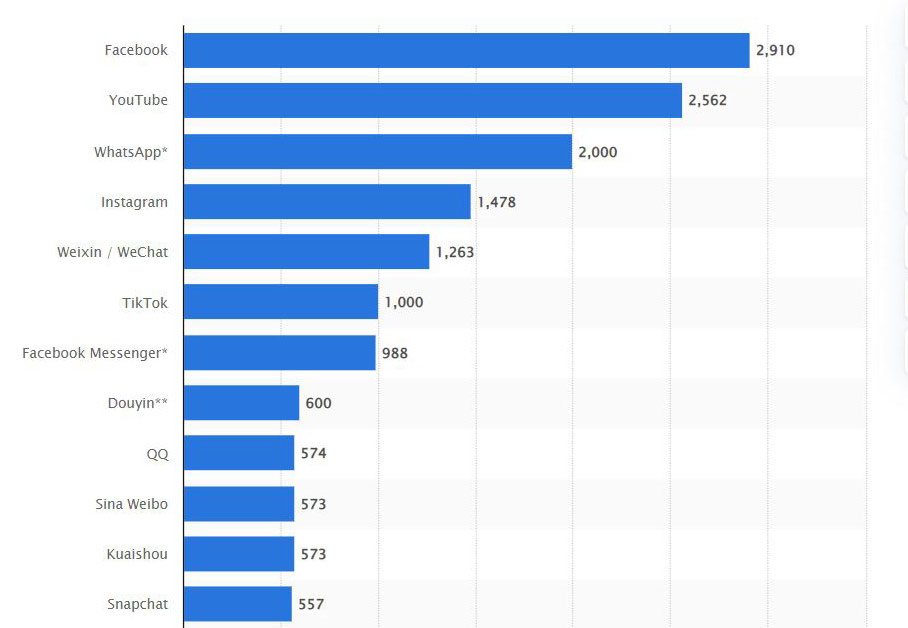If done right, social media marketing can take your business to a much higher level of success. In fact, 93% of marketers stated that their social media marketing campaign significantly increased their brand exposure, while 87% of them reported increased traffic.
Social media platforms are now one of the most prominent places to conduct business. Around 48% of young adults on the internet buy products from social media marketplaces and are likely to spend 20% to 40% more than a customer.
To profit from social media marketing, therefore, needs to be carefully developed and geared precisely toward a specific target audience. Otherwise, without a specific direction, your social media campaign will fail to bring you the desired outcome.
Hence, the first logical step for developing a social media marketing campaign is to identify your target audience. But, before that, we need to clarify what the term “social media target audience” actually means.
What Does “Social Media Target Audience” Mean?
Generally, the group of people you want your marketing efforts to capture is your target audience. However, we need to clarify the difference between your target market and target audience. Your target market is the group of people to whom you want to sell your products.
On the other hand, the target audience is the audience you want your marketing campaign to reach on social networking sites. For example, if your business is a rent-a-car service, your audience is those who may need rented cars for long trips.
You can run two separate marketing campaigns – one for families and one for young adults who love road trips with friends. Therefore, you have identified two different target audience groups for your business.
You need to make sure all the elements of your specific marketing campaign will attract your target audience and, eventually, generate sales. Since they will be the center of your social media marketing planning and design process, it is very important to determine them first. So let’s see how to do that.
How To Find Your Target Audience On Social Media?
Finding your target audience on social media is not a complex process, but it takes time, effort, and a desire to conduct extensive research. Below, we have outlined this process in six steps.
Analyze Your Existing Customers And Audience
The first step is to gather data on your existing social media audience and other customers. If your business is new to social media, focus this search on your target and existing customers. Here is all the information you need to collect.

- Location
Identify what geographic areas you want to target. For example, if your business operates in the US, you can check which states have what percentages of your existing customer and audience base.
- Age Range
Determine a rough estimate of the entire age range of your existing market and audience. This will help you to understand which generations you are serving and, later, which portion of existing customers you can effectively reach through social media marketing.
- Employment
You don’t need to be specific here. Just try to gather some general information regarding the industries where most of your audiences work. Try to have an estimate of their income levels to determine what socio-economic class to target.
- Culture
To successfully identify and understand your target audience, it is imperative for you to determine what values, norms, ideologies, and practices your brand is comfortable addressing.
- Language
Your language may not be similar to your audience’s native language, or their mother tongue. Hence, determine the language your current customers and audience feel comfortable communicating in.
- Interests
Try to find out what are the common interests of your current audience. Gather information on their hobbies, favorite movies and tv shows, favorite music genre, favorite sports, other recreational activities, and what other kinds of brands and businesses they interact with.
- Purchase Patterns
Try to understand your existing market’s purchase pattern and spending power. For example, how much money are they likely to spend on social media shopping? How often do they buy products from online marketplaces? Things like that.
- Needs
Identify the needs of your existing customers you are solving with your offerings. Find out your current audiences’ pain points as well. This will help you to determine what features to highlight in your social media marketing campaign.
How To Gather Relevant Data?
Now that you know what data to collect, you need to determine how to collect them. If you already have your own customer database, you can gather most of your information from there. Do not forget to collect data from your previous market research and campaigns, if you conducted any.
If you do not have such a database, a survey may be a good way to do this. You can conduct both offline and online surveys.
In addition, you should also consider using analytics tools like Google Analytics and Facebook Insights. Such tools help you gather demographic and behavioral information about your existing social media audience. You can take advice from social media marketers and experts as well.
On platforms like Quora and Reddit, it is possible to find opinions from experienced marketers. You can also engage in discussions on online forums and communities to get an idea of how your target audience thinks.
Identify Your Current Audience’s Most Preferred Social Media Platforms
Next, find out where your existing audience is most active. You can use surveys to gather this information. Consider different time zones as well because it will help you to understand when is the best time to post your promotional materials.
According to Statista, Facebook is estimated to have 2.9 billion monthly active users in January 2022. And by 2025, Instagram is forecasted to have 1.44 billion monthly active users, which is a 3.2% increase from 2021.
Twitter’s total user base will reach 497.48 million. Another platform to watch for is TikTok, which currently has 1 billion active users, and has ranked as the 4th highest ROI generator among all social media platforms, just within five years. The more you observe the activities and interactions of your current audience on social media platforms, the more potential target market you will discover.
For example, while older generations have increased their Facebook presence, young adults have moved more toward Twitter and Instagram. You can also find social groups on different platforms, like Facebook, and Reddit. At this stage, taking insights from social media analytics tools is crucial.

Conduct Social Listening
You need to understand what people say about your industry, products, and business. Identify relevant hashtags and keywords, to keep monitoring them while gaining valuable insights. Interact with posts where a relevant topic is being discussed.
Add the keywords and hashtags to your own posts as well. Observe the people who are actively showing interest in your industry and business. You’ll get more potential target audiences to study and get valuable insights on how to develop your social media marketing and yield the best output.
Analyze Your Competition
You will also need to analyze your competitors. Some of them are likely to be already engaged in social media marketing. Closely observe what they do and identify their target audience. Gather information on them as well, as they are your potential target audience. Moreover, understand how people are responding to those social media marketing campaigns to understand them further.
Profile Your Existing Customers And Audience
By now, you should have a wealth of data on your current and potential target market and audience. It is finally time to organize them. First, arrange the information based on their measures. For example, the top 3 social media platforms used, the most common cultural norms, the most common age range and income level, purchase behaviors, most common interests, etc.
Next, make segments based on a category, such as age or location. Then make detailed profiles for each group- where they are active, what the culture is like, what the income level and buying pattern are, what the common interests are, and so on. Use this portion of organized and filtered data for the next stage.
Determine Your Target Audience
Analyze all the information from the previous stage and identify your ideal target audience profile. Narrow them down to smaller groups and decide which segment can be reached most effectively through social media marketing.

For example, imagine that you are an Android tablet manufacturer. Your research revealed that most of your existing customers and audiences are from the US and Canada, 18 to 30 years old, with mid-level income, more liberal in views like traveling, sports, and gaming, somewhat price sensitive, and want a tab with good battery power.
You also identified they are primarily active on Instagram and Twitter, and primarily interact with travelers, gamers, sportspersons, fans, and such communities. Now suppose social listening and competitor analysis revealed that there are more people interested in tabs who are between 31 to 50 years old, with families and higher income, and more active on Facebook. So now, your potential target audience has grown bigger.
Final Thoughts
After analyzing all this information, you can run two different social media campaigns, for two slightly different target audiences, on two different platforms. Even if you focus on one, you will still have a clear idea of who your target audience is and design your campaign accordingly.
After you finally pinpoint your target audience, start connecting with them. Do not only post your marketing content, and move on. Keep interacting with them to increase engagement and encourage two-way communication.
However, in today’s fast-paced world, people’s needs, psychographics, behaviors, preferences, and even some demographic factors have been evolving rapidly. That is why it is best to conduct thorough market research periodically so that you can quickly adapt to such changes.




